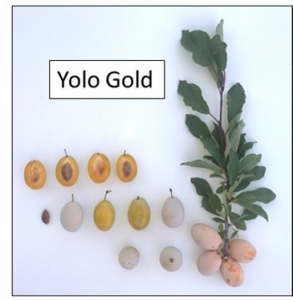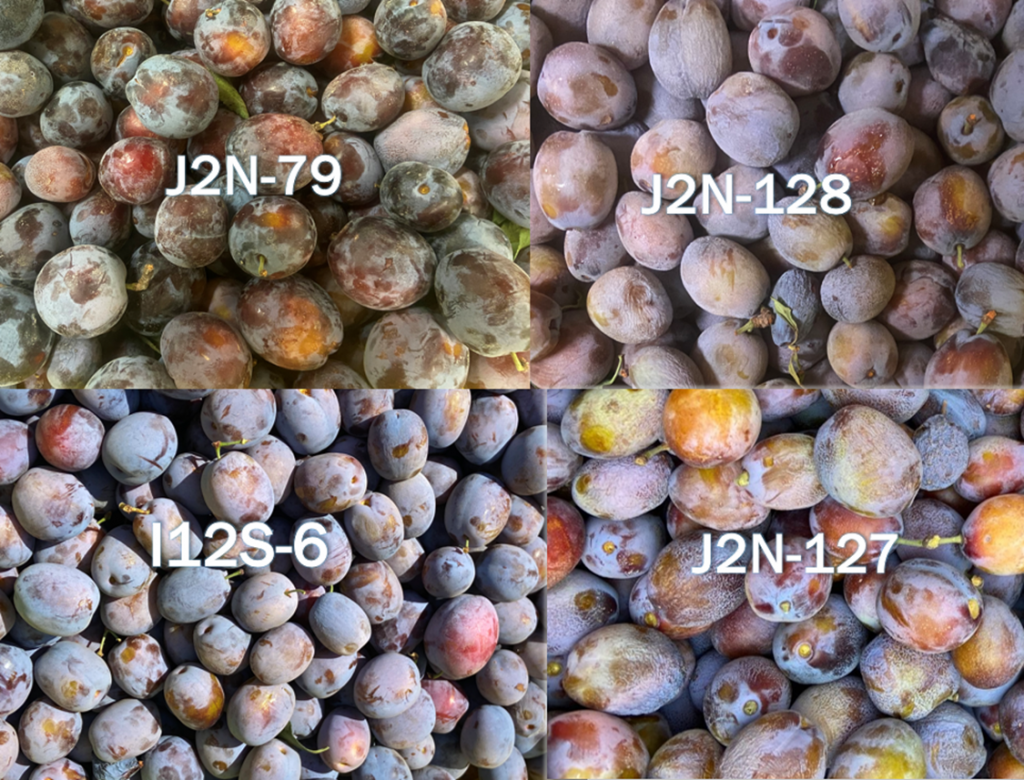Sarah Castro & Dr. Ted DeJong, Plant Sciences Department, UC Davis
The UC Davis Prune breeding program patented a new variety in 2023, and we are promoting new promising French-type selections. The new variety, ‘UC-Yolo Gold’TM, offers superior flavor and a late harvest date. The French types have a variety of harvest and bloom dates, and all have low dry-away ratios that are sure to draw attention from prune growers interested in lowering their operational costs. Many of the cultivars have been test-processed and dried using commercial dehydrators in cooperation with interested growers.
The breeding program aims to breed new cultivars that will save growers on operational costs and stabilize prune production in California. This program is directed toward reducing drying costs with lower fruit dry-away ratios and lowering production costs by reducing pruning. The program has many new items every year that are commercially viable candidates for future release. Many of the new selections are well suited for high-density situations because these new tree types produce fruit within three years of planting. In high-density plantings, the orchard trees are not trained to establish scaffolds but rather to settle down and produce fruit as early as possible. These new varieties can produce fruit in the second leaf, thus making them perfect candidates for high-density orchards.
UC-Yolo GoldTM :
Pro: Tastes superior Con: Doesn’t mix with Improved French
 UC-Yolo GoldTM is a prune tree that has yellow fruit that can begin to dry on the tree before there is substantial fruit drop. The tree blooms approximately 4 days before ‘Improved French’ and is ready for harvest approximately 10 days after ‘Improved French’. The fresh fruit is oval shaped and maintains its oval shape when dried. Fresh fruit weight is larger than ‘Improved French’ and dried fruit ranges from 9.8 to 11.9 g (38-46 ct/lb). Fresh to dryfruit weight ratios range from 2.5-3.1 depending on sugar content and fruit maturity. Fruit sugar contents range from 22 to 27 oBrix and fruit sugar content appears to be more affected by over-cropping than fruit size. The flowers are pollen self-compatible. The tree grows fairly upright and bears primarily on spurs and short shoots. The tree is more precocious than ‘Improved French’, meaning it will produce fruit earlier in its life. This tree has been selected primarily for its consistent bearing and dried fruit quality and flavor. Was successfully dried and pitted by Mariani in 2020, then Sunsweet in 2021.
UC-Yolo GoldTM is a prune tree that has yellow fruit that can begin to dry on the tree before there is substantial fruit drop. The tree blooms approximately 4 days before ‘Improved French’ and is ready for harvest approximately 10 days after ‘Improved French’. The fresh fruit is oval shaped and maintains its oval shape when dried. Fresh fruit weight is larger than ‘Improved French’ and dried fruit ranges from 9.8 to 11.9 g (38-46 ct/lb). Fresh to dryfruit weight ratios range from 2.5-3.1 depending on sugar content and fruit maturity. Fruit sugar contents range from 22 to 27 oBrix and fruit sugar content appears to be more affected by over-cropping than fruit size. The flowers are pollen self-compatible. The tree grows fairly upright and bears primarily on spurs and short shoots. The tree is more precocious than ‘Improved French’, meaning it will produce fruit earlier in its life. This tree has been selected primarily for its consistent bearing and dried fruit quality and flavor. Was successfully dried and pitted by Mariani in 2020, then Sunsweet in 2021.
In addition to our new release, we have obtained very encouraging results from a set of four new advanced selections that mature before and after ‘Improved French’. Like ‘Improved French’, these selections are pollen self-fertile (J2N-79 is still in the confirmation process). All of these selections develop fruit with very high sugar content and have low dry away ratios and taste great (see Table 1). They offer differing harvest dates but produce dried fruit that would be able to be easily mixed with Improved French. We are looking for grower cooperators to plant test trees of the items listed below.
J2N-128 This prune tree produces purple fruit that harvests a week or two after ‘Improved French’. The fruit has a fresh to dry weight ratio of 2.2-2.4 with a sweet, satisfying prune flavor. The fruit does not typically get softer than 4 lbs pressure because the fruit will start to dry on the tree rather than softening and falling off. This leafy tree is upright in structure and is more spur bearing than ‘Improved French’. The tree blooms about a week before ‘Improved French’ and harvests approximately 10 days after. Tree has never been test pitted, but will likely have no problems being dried and pitted. The tree is precocious, meaning it will produce fruit early in life, usually after its first leaf.
J2N-127 This prune tree produces purple fruit that can begin to dry on the tree before any substantial drop. It harvests with or around ‘Improved French’ time, but blooms about 10 days before ‘Improved French’. The fresh fruit size is about 15.8-25.5 g and the dried fruit weight ranges from 7.3 to 9.5 g. Fruit sugar contents range from 27.1 to 37.4 0Brix. The fresh to dry weight ratios range from 1.9 to 2.9. To obtain the lowest possible fresh to dry ratio, the fruit needs to hang on the tree, and start to shrivel. This item combines the convenience of a really low fresh to dry weight ratio while also having good dried fruit quality. The trees are very precocious; they can produce fruit on first leaf trees. The trees are fairly upright, spur bearing and consistently set a crop. If over-cropped, the fruit size will decrease, but no biannual bearing has been detected in subsequent years after good crops. A one acre test planting with bare root trees is being planted near Yuba City in 2022.
J2N-79 The prune tree produces dense purple fruit that harvests around or after ‘Improved French’. The fresh to dry weight ratio ranges from 2.0 to 2.9 depending on how long the fruit hangs on the tree before harvest. The fruit does not soften like ‘Improved French’, sugars increase due to fruit partially drying on the tree and consequently the flesh does not soften. The dried fruit is very dense and tough in its natural condition before pitting, but the processed fruit is very pleasant to eat with soft flesh and texture. The fruit size varies depending on crop load. This tree should not be over-cropped. The flowers typically bloom 6 days before ‘Improved French’, and the pollen is likely self-compatible, but this is being confirmed in 2022. Tree structure is upright with a tendency to be spur-bearing.
I12S-6 This is a purple prune that has shown promise with an exceptionally long harvest window extending from a week before ‘Improved French’ to nearly one month later with minor changes in flesh pressures but increasing fruit soluble solids. The fresh and dried fruit is an oval shape and the fresh fruit ranges between 24.1 to 32.9 g while the dried fruit ranges from 9.0 to 10.4 g. Fruit sugar contents range from 27.5 to 35.8 0Brix. Fresh to dry weight ratios can range from 2.3 to 2.8. Flowers bloom about 11 days before ‘Improved French’ and are pollen self-compatible. This tree is very precocious, it will produce flowers on first leaf trees. The dried fruit is very pleasant to eat with a semi-free pit and good prune flavor.

Table 1. The newest promising items available for testing from the UC Davis Prune Breeding program. Many items start to dry on the tree before harvest, and all have had at least four years of promising fresh and dried evaluations.
The prune breeding program is funded by the Prune Board of California. The breeding program aims to breed new cultivars that will save growers on operational costs and stabilize prune production in California. The main costs the program tries to reduce are drying costs (via dry away ratio) and pruning costs. The program has many new items every year that are commercially viable candidates for future release. We try hard to test these items as much as possible but help is needed from the industry to evaluate them thoroughly. For example, rootstock compatibility is still being determined, specifically with Krymsk 86. Extra tests around California help bolster our confidence that these items will reduce grower costs and revitalize the California prune industry. If you are interested in planting some new cultivars, please contact Sarah (scastro@ucdavis.edu). The Prune Board has a subsidy program that helps reduce your financial risk. Another way to learn about this program is to follow it on Instagram at @cali.prunebreeder.
For more information about these items please contact Sarah Castro at scastro@ucdavis.edu. Instagram: @cali.prunebreeder



Leave a Reply